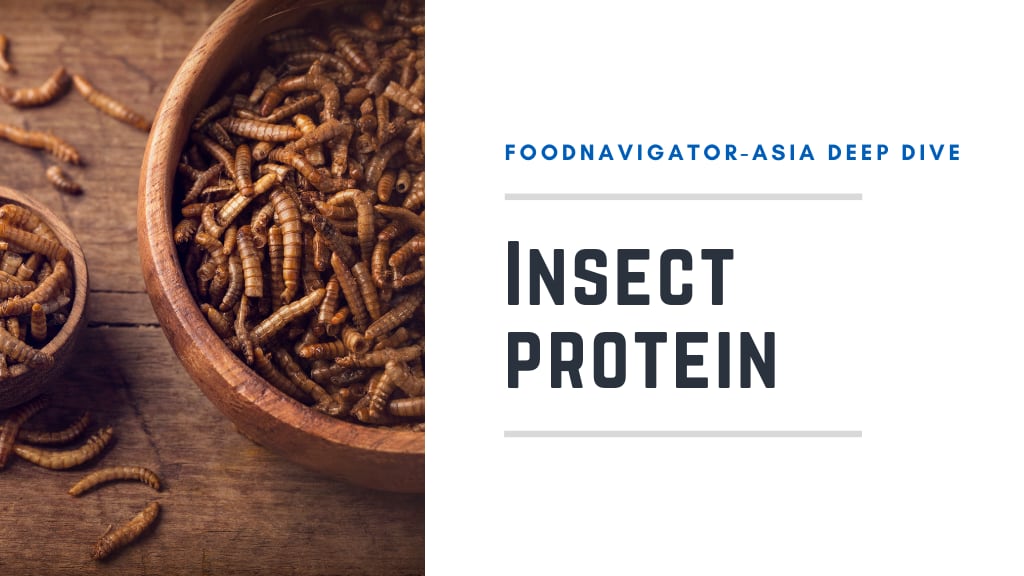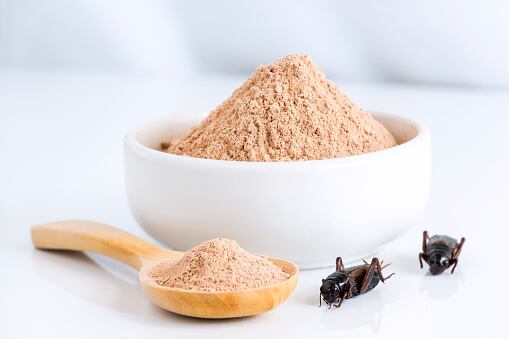In this edition of the FNA Deep Dive, we take a closer look at the trends that continue to slowly but surely drive the growth of the insect protein foods sector, and the major challenges continuing to hinder it in the APAC region.
Insect protein has received a great deal of interest in the past few years as a potential source of alternative protein to solve the world’s sustainable protein sourcing challenges, but even though this has seen resounding success in western markets, the same level of acceptance has yet to be seen in the Asia Pacific region.
This is ironic because Asia is commonly viewed as the most cost-effective region for insect protein production, both in terms of ingredient supply and input costs; plus the fact that the consumption of whole insects as a traditional delicacy has been common in several South East Asian countries for centuries – making the unsuccessful transition of this over to products made from insect protein strange, to say the least.
This is compounded by the fact that insect protein foods have evolved by many leaps and bounds in markets such as the United States over the past few years, a market where entomophagy or the consumption of insects has not had much of a traditional place in consumer diets.
Many players in the APAC insect protein foods sector are still looking for that major break to come through, such as Vietnam’s CricketOne.
“There is no doubt that the market is much more mature for insect protein foods consumption over in the West, particularly in North America,” CricketOne Business Development Director Bicky Nguyen told FoodNavigator-Asia.
“Five to seven years ago if you asked consumers there why they would want to eat insects or crickets, the responses would be mostly about the environment and sustainability and we would market based on that – but nowadays, we don’t need to sell that beautiful story anymore, and just need to focus on how tasty the product is and the health benefits as the market is already there and the education on this sector has done its job.
“The formats that people talk about are already far beyond what can be found in Asia – it’s become common to find insect chips, protein bars, energy bars, protein shakes and so on, in fact it’s very common there and there are even more advanced products in the US like RTE food packets, seasoning powders, seasoning sauces, cooking sauces and so on.
“Whereas here in Asia, there’s still a lot lacking in terms of awareness and most consumers are still trying to be convinced – the story is still on how sustainable it is and how environmentally friendly it is, and there’s still a bit of doubt on the taste side.
“So I would say for the Asian market, we are still a few steps behind but at least now people are starting to be more aware of the sector and are even looking for such products.”
To overcome this challenge, Nguyen believes that the breakthrough answer lies in snacks, and that this would be the most effective format to bring insect protein to a wider audience.
“The way to penetrate the market here is going to be via snacks, there is no doubt about it,” she said.
“Everyone loves snacks, especially a healthy snack that tastes good – and to be honest we still need a lot of hits to make consumers really embrace the sector and snacking is the best way to do that.
“The main difficulty for us hindering growth is that our technology is proven, our model works and for CricketOne we have proven that we can farm crickets at a very large scale with minimal impacts on the environment and minimal input resources – but the bottleneck is that we don’t want to grow too far ahead of the market readiness here.
“It will still take time for consumers to really accept insect protein readily, and we believe that this is because there is still a lack of products in the market that look familiar to consumers and that are easy for them to prepare at home, so the convenience and accessibility factors are not quite fulfilled for them yet.
“The last and also very important factor is affordability too, as launching a new product is still very risky and the investment is high, so that’s also a point we need to solve soon, but we believe when that is done we will be able to shorten the whole funnel to bring products to consumers more quickly and accelerate their acceptance.”
Watch the video below to find out more:
Formats and functions
Many other insect protein food firms in the APAC region are in firm agreement with CricketOne when it comes to the snacking format, with most that have launched products for direct consumer retail having innovated in this area.
Most of these have looked to savoury snacks but market these as healthier snacking options, such as Thailand’s Kokoonic which specialises in silk pupae as its main source of insect protein for its Eri Rocket range of snacks.
“The Eri Rocket snack range is baked not fried, high in protein (3g) and low in sodium, making these ideal for healthier snacking,” Kokoonic Managing Director Dumrong Kongkiatrai said.
“Our first two flavours are cheese and grilled squid; and the snacks contain a blend of pupae powder, jasmine rice and corn flakes so they still have that snackable crunch alongside the high protein from the pupae.
“It also contains natural oils and fatty acids that are comparable in nutritional benefits to fish oil whilst also being a cleaner, more sustainable option due to the manner of farming.”
There are also several ambitious brands which have looked into using insect protein for sweet snacks such as Cric-Co, which has focused its efforts on creating brownies out of cricket protein.
“Insect brownies may still seem quite novel for the region here, but this is actually quite common over in the western markets,” Cric-Co Director Nuttathida Tantianon told us.
“So to maximise our uniqueness, we decided to use 100% cricket powder to make the brownies as opposed to the more common 30% or 40% used by other firms – this ensures that we are unique not only here, but also have a foothold in other regional markets.”
Strength in production
One of Cric-Co’s other major selling points is in its localised supply chain, which Tantianon said was beneficial from the various sustainability, ethical and cost points of view.
“The thing about being based in South East Asia is that we are able to buy from local cricket farms, process to add value to the products, sell these to the world and then give back to the local communities from the profits,” she said.
“This is a very important way to keep the business sustainable, and is what we hope to reflect to both our local and international consumers.”
This point of view was resonated by one of the key voices for insect protein foods in the region, Global Bugs Asia, which also highlighted production strength as one of the key reasons that confidence in the region’s insect protein sector remains so high despite the many challenges it has yet to overcome.
“Asia is definitely the main region for insect farming – Thailand alone has thousands of small local farms,” Global Bugs Asia Strategic Business Development Director Stefan Jarheim said.
“We know that the production here is strong – but taking the step from being a small farm up to a large one able to export globally requires a lot more than just farming and processing insects, but also innovation and education.
“The trend of insect farming, insect rearing, combining insects in as an ingredient to food is definitely on the rise and replacing meats in foods with insects is on the rise and gaining more awareness, which is a big driver.
“We have already been seeing an increase in demand from large companies wanting insect protein to use in food products to improve their nutritional profile, so this is definitely positive.”
Large brand interest
Nguyen added that CricketOne has also been seeing a surge in larger companies showing interest in using crickets to innovate product recipes, stressing that this is a key turning point for the industry.
“It’s exciting as when we look at the players that can really make strong impacts on the consumers, these are the ones with the financial power to educate the consumers and launch different products, to invest in deep R&D, to make the packaging really flashy and tempting and eye-catching – these are the medium and large scale brands, and they are looking into this sector too,” she said.
“So this means that the sector is now not just a testing ground for start-ups but also other key players with that backing, and this is a very important opportunity for the sector to grow because at the end of the day although it’s definitely faster for start-ups to launch products, the ability to create recurrent sales is not easy and they need a lot of money invested into marketing and education.
“This is where medium and large players come in as although it is also costly for them to launch new products, they already have their fundamental playground with distributors, partners and all sorts of value chains available to them – so hopefully this interest will translate into a big leap in market growth.”
One of the biggest names known to have taken an interest in this sector is definitely Thai Union, which has invested in multiple insect protein start-ups such as Flying SpArk and Orgafeed.
“Insect protein is a business we believe will complement Thai Union’s activities as we broaden our business beyond our traditional core,” Thai Union CEO Thiraphong Chansiri said.
“We plan to increasingly co-operate with innovative start-ups in strategically interesting areas [such as insect protein] in the coming decade.”
The firm has also highlighted insect protein as a key emerging area of interest for alternative protein research.
Food ingredients giant Archer Daniels Midland (ADM) is also dabbling in the insect protein sector, planning for the construction of the ‘world’s largest insect protein facility’ in partnership with insect protein firm InnovaFeed.
Packing up the yuck
It does still remain to be seen whether the sector will be able to overcome its most fearsome challenge – the ‘yuck’ factor – in APAC in the near future, although Nguyen believes that if the format and mindset changes come through, there is no reason why transformation such as has been seen in the west should not happen here too.
“It’s still the education and the creation of convenient, accessible, easy-to-accept product formats – and we do believe that snacks are the way forward but are also producing various different products to make applications and adoption more convenient, so as to expand the spectrum,” she said.
“If we’re talking from a B2B perspective, this can be done by providing different products for use in baking, for beverages, for extrusion, and so on – and this can also be translated into product innovations with a more direct impact on consumers.”
Jarheim agreed that the yuck factor still exists, but also argued that the nutritional benefits are going to be key in helping consumers overcome this.
“The ‘ewwww’ or ‘yuck’ factor is still a main challenge right now because consumers that hear there are insects in their food tend to show pushback and outright go ‘I’m not going to touch that now’,” he said.
“But the demand for alternative high quality protein is undoubtedly on the rise, and given that these insects do contain a lot of nutritional values such as amino acids, iron, magnesium, calcium and so on, there is a really good argument for people to move past that and accept it as a food, particularly if it comes in more acceptable formats like powders or snacks.”





